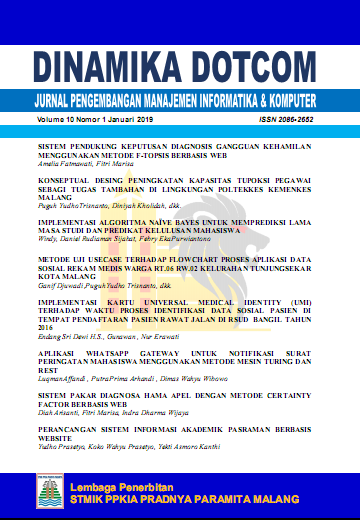IMPLEMENTASI KARTU UNIVERSAL MEDICAL IDENTITY (UMI) TERHADAP WAKTU PROSES IDENTIFIKASI DATA SOSIAL PASIEN DI TEMPAT PENDAFTARAN PASIEN RAWAT JALAN DI RSUD BANGIL TAHUN 2016
Abstract
The first time patient visits the health care facilities is to be identified the social data of the patient. Patient registration by using the register book takes a lot of time and extend the registration process. Universal Medical Identity card (UMI) is the choice to shortening the time process of identification the social data of the patient. The aim of this research was to implement the UMI card against time identification process social data of the patient. The data obtained through observation and the time for identify the social data of patients was recorded before and after the implementation of UMI cards. Sample were the new outpatient who came to the patient regristration desk (TPPRJ) in Bangil Hospital, Pasuruan City. The statistical test using Independent t-Test proved that there was a different mean time of identification the social data of the patient before and after using the UMI card, with significancy value p < 0,05. It is suggested to use this UMI card at the patient regristration desk (TPPRJ) in Bangil Hospital, Pasuruan City, to speed up the time process of identification the social data of the patient.
Key words : UMI (Universal Medical Identity ) card , time process of identification the social data of the patient
References
Anonim. 2004. Smart Cards (a.k.a IC cards or Chip cards). Diakses: Diakses: 01 November 2015. http://www.smartcard.bull.com
Anonim. Tanpa tahun. Keuntungan dan Kekurangan RFID. Diakses: 06 Maret 2016. http://www.wordpress.com/ myblog.htm
Arief. 2014. Pengertian Fungsi dan Kegunaan Arduino. Diakses: 03 Maret 2016. https://ariefeeiiggeennblog.wordpress.com/2014/02/07/ pengertian-fungsi-dan-kegunaan-arduino/htm.
Arikunto, Suharsini. 2006. Prosedur Penelitian Suatu Pendekatan Praktik. Jakarta: Rineka Cipta
Azwar, Azrul. (2010). Pengantar Adminitrasi Kesehatan, Edisi Ketiga. Jakarta: PT. Bina Rupa Aksara.
Azwar, Marlina. 2015. Pedoman Identifikasi Pasien Di Rumah Sakit. Diakses: 8 Maret 2016. Http://www.marlinaazblogspot.com/2015/pedoman-identifikasi-pasien-rumah-sakit.html
Budi, Savitri Citra. 2011. Manajemen Unit Kerja Rekam Medis. Yogjakarta: Quantum Sinergis Media
Departemen Kesehatan RI. 2007. Pedoman Penyelenggaraan Dan Prosedur Rekam Medis Rumah Sakit Di Indonesia. Revisi II. Jakarta: Depkes RI.
Hatta, Gemala. 2008. Pedoman Manajemen Informasi Kesehatan di Sarana Pelayanan Kesehatan. Jakarta: UI Press
Manley, D. 2004. Smart Cards. Diakses: Diakses: 01 November 2015. http://www.comp.dit.ie/dmanley
Menteri Kesehatan RI. 2008. Keputusan Menteri Kesehatan RI No.129 Tahun 2008. Standar Pelayanan Minimal Rumah Sakit. Jakarta: Kemenkes RI
Notoatmodjo S. 2012. Metodologi Penelitian Kesehatan. Jakarta:Rineka Cipta.
Nursalam. 2008. Konsep dan Penerapan Metodologi Penelitian Ilmu Keperawatan. Surabaya: Salemba Medika.
Riyanto, Agus. (2010). Pengolahan dan Analisis Data Kesehatan. Yogyakarta: Nuha Medika
Shofari, B. 2002. Pengelolaan Sistem Pelayanan Rekam Medis di Rumah Sakit.Jakarta : Rineka Cipta.
Sulistiyorini, Christina,dkk. 2008.Tinjauan Faktor Penyebab Waktu Tunggu Pelayanan Pendaftaran Pasien Umum Rawat Jalan Di Rumah Sakit Umum Daerah Sragen. Karanganyar.
Tularsih, Endang. 2012. Tinjauan Peran Bagian Rekam Medis Dalam Pelaksanaan Program Akreditasi JCIA Disebuah Rumah Sakit. [KTI]. Jogjakarta: Jurusan Rekam Medis UGM
Yefriadi. 2010. Aplikasi Smart Card Untuk Electronic Medical Record (EMR). Poli Rekayasa Vol.5,No 2, Maret 2010:137-147


